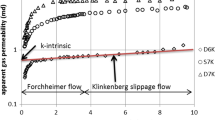Abstract
Invasion percolation was studied on three-dimensional regular lattices of various node numbers. A new model has been developed to obtain the pore-size distribution from capillary pressure measurements. The new model is superior to the conventional percolation model, since it takes into account the physical trapping of the wetting phase. The irreducible wetting phase saturation includes the film of the wall of the pores, the dead-end pore volume, and the main contribution by pores isolated from the outlet of the medium by the nonwetting phase. This has been related to the node number and the sample 3dimensions. Over 100 capillary pressure curves of consolidated media have been collected. Good agreement was obtained between this data set out and our invasion percolation predictions using node numbers of 6–13, as reported by Mishra and Sharma. The pore-throat size distribution function estimated by our new model is broader than from the conventional percolation and the capillary tube models.
Similar content being viewed by others
Abbreviations
- c :
-
constant
- D :
-
pore throat diameter [m]
- D max :
-
maximum pore diameter [m]
- f(D) :
-
correlation function of pore throat size and pore body size
- L :
-
a parameter representing the dimension of a sample
- n :
-
node number
- p :
-
pressure [N/m2]
- S n :
-
the nonwetting phase saturation
- x :
-
random number ranging from 0 to 1.0
- X a :
-
∂X a t /∂X/ t
- X a e :
-
X a t −X i t
- X i :
-
∂X i t /∂X a t
- X nw :
-
fraction of pore volume occupied by the injected phase
- X t :
-
fraction of pores larger thanD
- X a t :
-
total accessibility of pores larger thanD
- X i t :
-
total isolation of pores larger thanD
- θ :
-
contact angle
- σ :
-
interfacial tension [N/m]
- α(D) :
-
pore throat size distribution
References
Androutsopoulos, G. P. and Mann, R., 1979: Evaluation of Mercury porosimetry experiments using network pore structure model,Chem. Eng. Sci. 34, 1203–1212.
Chatzis, I. and Dullien, F. A. L., 1977: Modelling pore structure by 2-D and 3-D networks of capillary tubes to simulate the drainage capillary pressure curves of sandstones,J. Canad. Petrol. Technol. 16, 97–108.
Diaz, C. E., Chatzis, I., and Dullien, F. A. L., 1987: Simulation of capillary pressure curve using bond correlated site percolation on a sample cubic network,Transport in Porous Media 2, 215–240.
Dullien, F. A. L. and Dhawan, G. K., 1973: Photomicrographic size distribution determination of non-spherical objects,Powder Tech. 7, 305–313.
Dullien, F. A. L. and Dhawan, G. K., 1974: Characterization of pore structure by a combination of quantitative photomicrography and mercury porosimetry,J. Colloid Interface Sci. 42(2), 337–349.
Fatt, I., 1956: The network model of porous media I. Capillary pressures characteristics,Trans AIME 207, 144–150.
Lake, L. W., 1989:Enhanced Oil Recovery, Prentice-Hall, Englewood Cliffs.
Larson, R. G. and Morrow, N. R., 1981: Effects of sample size on capillary pressure in porous media,Powder Tech. 30, 123–128.
Larson, R. G., Scriven, L. E., and Davis, H. T., 1981: Percolation of two phase flow in porous media,Chem. Eng. Sci. 36, 57–73.
Mishra, B. K. and Sharma, M. M., 1988: Measurement of pore size distribution from capillary pressure curves,AIChE J. 34(4), 684–687.
Morrow, N. R., 1970: Irreducible wetting-phase saturation in porous media,Chem. Eng. Sci. 25, 1799–1815.
Wardlaw, N. C., 1990: Quantitative determination of pore structure and application to fluid displacement in reservoir rock,North Sea Oil and Gas Reservoir-11, Graham and Trotman, pp. 229–243.
Wardlaw, N. C., Li, Y., and Forbes, D., 1987: Pore throat size correlation from capillary pressure curves,Transport in Porous Media 2, 597–614.
Washburn, E. W., 1921: Note on a method of determinating the distribution of pore size in porous material,Proc. Natl. Acad. Sci. 7, 115.
Zhou, D., 1990: Invasion percolation and its application in simulations of multiphase flow in porous media, PhD dissertation, Dept. of Chem. Eng., Technical University of Denmark.
Zhou, D. and Stenby, A. C., 1990: Immiscible displacement in porous medium simulated by a statistical model,North Sea Oil and Gas Reservoirs-II, Graham and Trotman, pp. 271–280.
Author information
Authors and Affiliations
Rights and permissions
About this article
Cite this article
Zhou, D., Stenby, E.H. Interpretation of capillary pressure curves using invasion percolation theory. Transp Porous Med 11, 17–31 (1993). https://doi.org/10.1007/BF00614632
Received:
Revised:
Issue Date:
DOI: https://doi.org/10.1007/BF00614632




